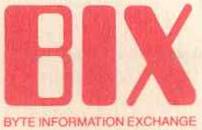 Way back when, back in 1987, I was studying engineering over at the University of Stellenbosch, and I read about this thing called BIX, the Byte (magazine) Information eXchange.
Way back when, back in 1987, I was studying engineering over at the University of Stellenbosch, and I read about this thing called BIX, the Byte (magazine) Information eXchange.
So I went over to Professor Krezinski at the Computer Science department and asked him nicely to let an engineer play with their toys and to my surprise he agreed. Gave me access to the building and organised an account on the DG, which was connected to some magic elf (X.25?) boxes which in turn connected to… BIX. Where I spent some time (not a whole lot, my father’s credit card was paying for my time) chatting to some very bright people. This was when smileys still looked like ^_^ and {^_^} (Hello jdow, wherever you are)
But there were other interesting computers in the lab (on the third floor, ISTR). Specifically, an AT&T 3B2 and a Fortune 32:16. And since I was designing a 68000-based computer at the time, I copied all the Fortune disks, thinking maybe, some day, I can make some of this stuff run on my machine.
That day has not yet come :-)
But I recently found those floppies again, and copied them using Dave Dunfield’s ImageDisk 1.18. And they were all still 100% readable (OK, on one floppy the jacket had warped, I had to remove the disk and stick it in a cleaning disk jacket to read it).
Bitsavers have some documentation online, and from this it’s clear that Fortune Systems never intended the user to poke around under the hood. Apart from the 68000 processor, I can’t find any details online about the chips used, the amount of ROM on the motherboard, or anything like that (Unleashing a hex editor at the diagnostics software shows mention of a Z-80 processor, as well as “CTC” and “SIO” and “dual port RAM” — sounds like an I/O device. There was apparently also some kind of an MMU).
Anyway, here are my disk images. Disks are 80 track, with five sectors of 1024 bytes each per side.
I’m not too sure how useful these will be, since this 2005 posting to ClassicCmp states that
They also had a reasonably effective copy-protection scheme. Uninstalled Fortune software on distribution media was encrypted using a key known to Fortune and to Fortune's installation program. When you installed software from the distribution media, the software would be decrypted and then re-encrypted using a key based on the motherboard serial number for storage on the hard disk (so you couldn't just copy the executables from your system to some other system: installed software only ran on the system on which it had been installed); and of course the installer marked the distribution medium as "installed" so you couldn't just go install it again somewhere else.
See also Fritz Hohl’s 2016 blog post here: https://randoc.wordpress.com/2016/06/05/fortune-systems/